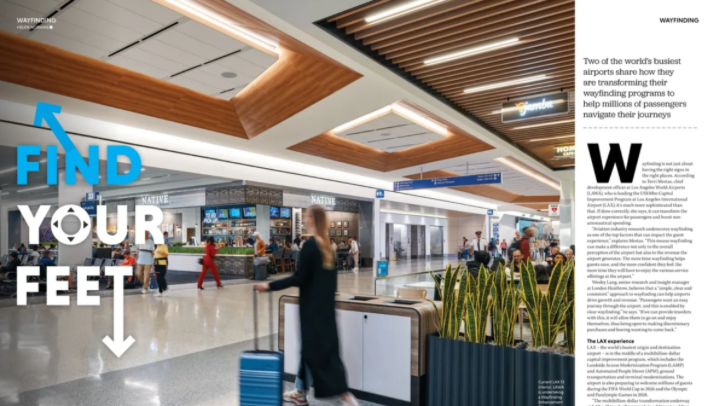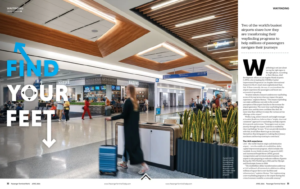Two of the world’s busiest airports share how they are transforming their wayfinding programs to help millions of passengers navigate their journeys.
Wayfinding is not just about having the right signs in the right places. According to Terri Mestas, chief development officer at Los Angeles World Airports (LAWA), who is leading the US$30bn Capital Improvement Program at Los Angeles International Airport (LAX), it’s much more sophisticated than that. If done correctly, she says, it can transform the airport experience for passengers and boost nonaeronautical spending.
“Aviation industry research underscores wayfinding as one of the top factors that can impact the guest experience,” explains Mestas. “This means wayfinding can make a difference not only to the overall perception of the airport but also to the revenue the airport generates. The more time wayfinding helps guests save, and the more confident they feel, the more time they will have to enjoy the various service offerings at the airport.”

The LAX experience
LAX – the world’s busiest origin and destination airport – is in the middle of a multibillion-dollar capital improvement program, which includes the Landside Access Modernization Program (LAMP) and Automated People Mover (APM), ground transportation and terminal modernizations. The airport is also preparing to welcome millions of guests during the FIFA World Cup in 2026 and the Olympic and Paralympic Games in 2028.
“The multibillion-dollar transformation underway at LAX will touch all terminals in addition to adding millions of square feet in new facilities and infrastructure,” explains Mestas. “Not implementing a new wayfinding program at the airport during this critical moment would be a noticeable misstep.”
To streamline the wayfinding experience at LAX, LAWA began by undertaking a comprehensive assessment of wayfinding at the airport in 2018 and is now developing a new wayfinding strategy along with updated signage and wayfinding standards.
“The standards represent a living document informed by ongoing development projects to expand the range of wayfinding products and services that will aid in meeting user needs across all environments and journey stages,” explains Mestas.

“The number one question we encounter at LAX is passengers asking for assistance to find an airline.”
Terri Mestas, Los Angeles World Airports
The wayfinding strategy aims to develop an innovative, inclusive, accessible, equitable, cohesive and uniform approach to wayfinding, which uses both digital and physical signage to guide guests consistently across the airport and its facilities.
“The new system will organize guests’ movements throughout newly interconnected terminals, the upcoming APM train system, Consolidated Rent-A-Car (ConRAC) facility and other amenities at LAX. A holistic and clear wayfinding system is needed to link these offerings while reducing traffic congestion in the Central Terminal Area (CTA) and improving the overall guest experience,” Mestas continues.
Currently, the wayfinding project is between the programming and early design stage and the multiphase design and construction rollout. “This year, we will engage a progressive design-builder firm that we will collaborate with further on the design and phasing strategy,” explains Mestas. “Once a prioritization plan is in place, the firm will implement the work, targeting completion before the Olympic and Paralympic Games.”
Work underway
While final designs for LAX’s new, consistent wayfinding solutions are being fine-tuned, the airport has begun work on making specific areas within the terminals more intuitive. “Based on the studies we carried out in 2018, we found out that the number one question we encounter at LAX is passengers asking for assistance to find an airline,” reveals Mestas.
To help tackle this, the new wayfinding program will create info hubs that equip guests with the information they need, including where they are, where they are going and what to expect next in their journey.
The airport is also implementing a campus-wide revised gate numbering system that will affect every airport environment and system (airfield, airside, landside, roadways, parking garages, APM train and more).
“Last year, we conducted a gap analysis of the LAX wayfinding standards,” says Mestas. “We identified that the naming conventions for gate renumbering would result in a highly complex information system that would add unnecessary stress to our guests’ journeys. We worked closely with stakeholders, staff, airlines and passengers – the latter in a user testing exercise – to develop a new alphanumeric approach [A1, B1, C1, etc] that people found easy and fast to navigate.

The management of digital content will also be updated. Currently, the airport manages digital content through various systems, but the hub is in the process of developing a campus-wide digital content management system (DCMS) that will enhance the guest journey by providing a unified, integrated digital content management platform for all the airport’s digital displays and digital passenger interfaces.


Across the pond in the UK, Heathrow Airport has recently completed a thorough wayfinding project that it hopes will elevate the passenger experience and, like LAX, create a consistent wayfinding approach across all its terminals. The project began with a wayfinding study to understand the passenger journey with the aim of optimizing it for both the airport and the traveler.
Speaking about why the study was needed, Lang says, “During Covid-19, a lot of extra signage and information was added throughout the passenger journey. As passenger volumes began to return following the pandemic, we started to see declines in satisfaction with wayfinding at Heathrow. So, there was a need to assess our wayfinding messaging to ensure passengers received a predictable and reliable journey. The hypothesis of the study was that we would get a read on optimal flow paths and poorly performing strategic signs.”
The wayfinding project ran from December 2022 to January 2023. It focused on Terminal 5 and involved intercepting passengers at several key journey touchpoints, such as arrival at the airport, check-in, post-security, disembarkation and onward transportation on arrival. “Participants were then asked to continue their journey from these points, and we tracked their eye movement throughout and followed it up with a qualitative in-depth interview at the end focusing on key challenges they faced along their journey,” Lang adds.
Passenger eye tracking
During the project, Heathrow worked closely with global tech firm Tobii, which used its eye-tracking technology to measure how people navigated through T5. “We also carried out post-session surveys and task evaluations, analyzed the data and compiled the results,” says Jon Ward, VP, EMEA at Tobii. “Thereafter we workshopped the findings to help Heathrow understand where challenges and opportunities were in its wayfinding, what was working well and chances for optimization.”

“During Covid-19, a lot of extra signage and information was added throughout the passenger journey.”
Wesley Lang, London Heathrow
Tobii used its Tobii Pro Glasses 3 eye-tracking solution on the Heathrow project. These glasses feature discreet cameras that view the participants’ eyes and a forward camera that films the environment they are moving around in. “Some very clever algorithms bring these together so that in real time we can see exactly where the participants are looking,” explains Ward. “Seeing through the eyes of the passenger using the eye-tracking technology allows us to pinpoint and measure every element of their journey, the interaction with the environment and their decision making process.”
The wayfinding study identified several bottlenecks and problems within Heathrow T5, with the most evident being in the Border Force area and with passengers trying to find trains to London. Ward explains, “Arriving passengers were met by a busy bottleneck when reaching the Border Force area, where lots of new information was presented and choices had to be made quickly. This new information and changed visual elements required people to recalibrate their focus to understand what was relevant to them so they could make the right choice. Passengers heading for the border rather than connections struggled the most, as it was not obvious which direction to go because the signage was easy to miss and the direction not intuitive.”

“People have limited time and are on the move, so any redundant information should be removed.”
Jon Ward, Tobii
Project findings
Now that the wayfinding project has been completed, Heathrow and Tobii have identified the main findings. One was that people look for informational consistency and instructive and directional clarity to guide them in their journeys. “People have limited time and are on the move, so any redundant information should be removed. You have a small amount of time to attract, engage and inform, so keep it concise,” Ward says.
The study also revealed that people tend to look up and beyond for information to plan their next steps – signs on floors, pillars and walls perform less effectively. And finally, people prefer to be told what to do rather than processing information themselves and then making decisions. “Make calls to action clear and simple with iconography to overcome language barriers,” Ward adds.
Overall, Heathrow has identified that it needs to be more consistent with its approach to wayfinding across the whole journey. “We need to avoid temporary tactical signage below head height and work on consolidating the volume of signage we have,” Lang explains.

Speaking about how successful the project has been, he continues, “We have managed to reverse the wayfinding satisfaction declines we were seeing in 2021 and 2022 by rationalizing the end-to-end wayfinding journey, particularly through decluttering walkways and decision points, reconfiguring the entrance to immigration and revamping onward travel signage.”
Although the study focused on T5, the work has also produced a set of best-practice recommendations that have now been applied to Heathrow’s overall wayfinding guidelines and standards to ensure better consistency across all its terminals.

This article originally appeared in the April 2024 issue of Passenger Terminal World. To view the magazine in full, click here.


